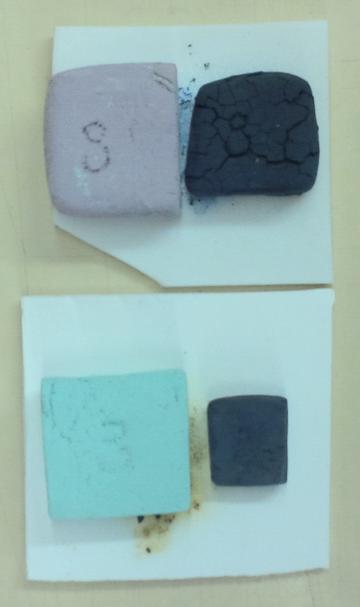| Monthly Tech-Tip | No tracking! No ads! | |
Cobalt Carbonate
Alternate Names: Spherocobaltite, CoCO3, Cobalt(II) carbonate
| Oxide | Analysis | Formula | Tolerance |
|---|---|---|---|
| CoO | 63.00% | 1.00 | |
| CO2 | 37.00% | n/a | |
| Oxide Weight | 74.92 | ||
| Formula Weight | 118.92 | ||
Notes
A pinkish-tan powder. It is a strong colorant and almost always produces blue in glazes (unless in very high percentages where it is black). Cobalt carbonate is an extremely active melter (even more than cobalt oxide), in a mix of 50% Ferro frit 3134 it will boil at cone 6. The carbonate form of cobalt is very fine-grained and disperses better in the glaze slurry and the glaze melt, it gives a more evenly distributed color than cobalt oxide. However, as with any carbonate, it produces gases as it decomposes and these can cause pinholes or blisters in glazes if they need to escape at the time when the glaze needs to solidify. The carbonate form contains less CoO (63% CoO vs. commercial cobalt oxide which is not actually 100% CoO but around 93%).
Supplies of this material often differ in the shade of the raw powder (lighter and darker). This is because available grades of Cobalt Carbonate are not actually CoCO3 but a mix of the carbonate and the hydroxide. Cobalt II carbonate theoretically would have the formula: CoCO3.3Co(OH)2.H2O.
The theoretical oxide form has 93% CoO while this has 63%. So if you want to switch from the oxide to the carbonate in a recipe, multiply by 93 and divide by 63. To switch from carbonate to oxide multiply by 63 and divide by 93. But remember that this will be approximate (for reasons discussed above and on the cobalt oxide page), you will likely need to fine-tune the amount based on fired results. In addition, the quality of the color may be different. Consider using a stain as a better solution.
Manufacturer information sheets often quote the percentage of Co instead of CoO (thus a lower amount in the range of 45-47%. Trace elements like Ni, Fe, Mn, Cu, Zn, Pb and Mg are quoted but none are in large enough amounts to worry about in ceramics. Na can be 0.5%. Products are sold based on Co content, higher purity grades may have only 1 or 2% higher Co content. Particle size can be about 2.5 microns.
The carbonate is produced from a liquid reaction between cobalt II acetate and sodium carbonate to produce red-violet crystals that are recovered by filtration. The material is insoluble in cold water but will decompose in hot water.
Related Information
How do metal oxides compare in their degrees of melting?

This picture has its own page with more detail, click here to see it.
These metal oxides have been mixed with 50% Ferro frit 3134 and fired to cone 6 oxidation. Chrome and rutile have not melted, copper and cobalt are extremely active melters, frothing and boiling. Cobalt and copper have crystallized during cooling. Manganese has formed an iridescent glass.
Pure cobalt carbonate and copper carbonate at 1850F

This picture has its own page with more detail, click here to see it.
Cobalt carbonate (top) and copper carbonate (bottom). Left is the raw powder plastic-formed into a sample (with 2% veegum). Right: fired to 1850F. The CuCO3 is quickly densifying over the past 100 degrees and should begin to melt soon. It is long past the fuming stage.
An example of how cobalt can precipitate in a fluid melt glaze at cone 6

This picture has its own page with more detail, click here to see it.
This glaze has a significant amount of cobalt carbonate and during cooling the excess is precipitating out into pink crystals during cooling in the kiln. This effect is unwanted because in this case since it produces an unpleasant surface and color (the photo does not clearly show how pink it is). This problem can be fixed by a combination of cooling the kiln faster, increasing the Al2O3 content in the glaze (it stiffens the melt and prevents crystal growth) or firing lower.
Testing cobalt carbonate from a new supplier

This picture has its own page with more detail, click here to see it.
That is easy. We just mixed 1 and 2% of our current material (top two samples) and the new one (bottom two) into our standard transparent glossy cone 6 base glaze.
Links
| Materials |
Cobalt Oxide
|
| Hazards |
Cobalt Toxicology
|
| Typecodes |
Generic Material
Generic materials are those with no brand name. Normally they are theoretical, the chemistry portrays what a specimen would be if it had no contamination. Generic materials are helpful in educational situations where students need to study material theory (later they graduate to dealing with real world materials). They are also helpful where the chemistry of an actual material is not known. Often the accuracy of calculations is sufficient using generic materials. |
| Typecodes |
Colorant
Metallic based materials that impart fired color to glazes and bodies. |
| Oxides | CoO - Cobalt Oxide |
| URLs |
https://digitalfire.com/4sight/datasheets/SDSArliminCobaltCarbonate.pdf
SDS Arlimin Cobalt Carbonate |
Data
| Frit Softening Point | Co3O4 D |
|---|---|
| Density (Specific Gravity) | 4.1 |
| By Tony Hansen Follow me on        |  |
Got a Question?
Buy me a coffee and we can talk

https://digitalfire.com, All Rights Reserved
Privacy Policy
